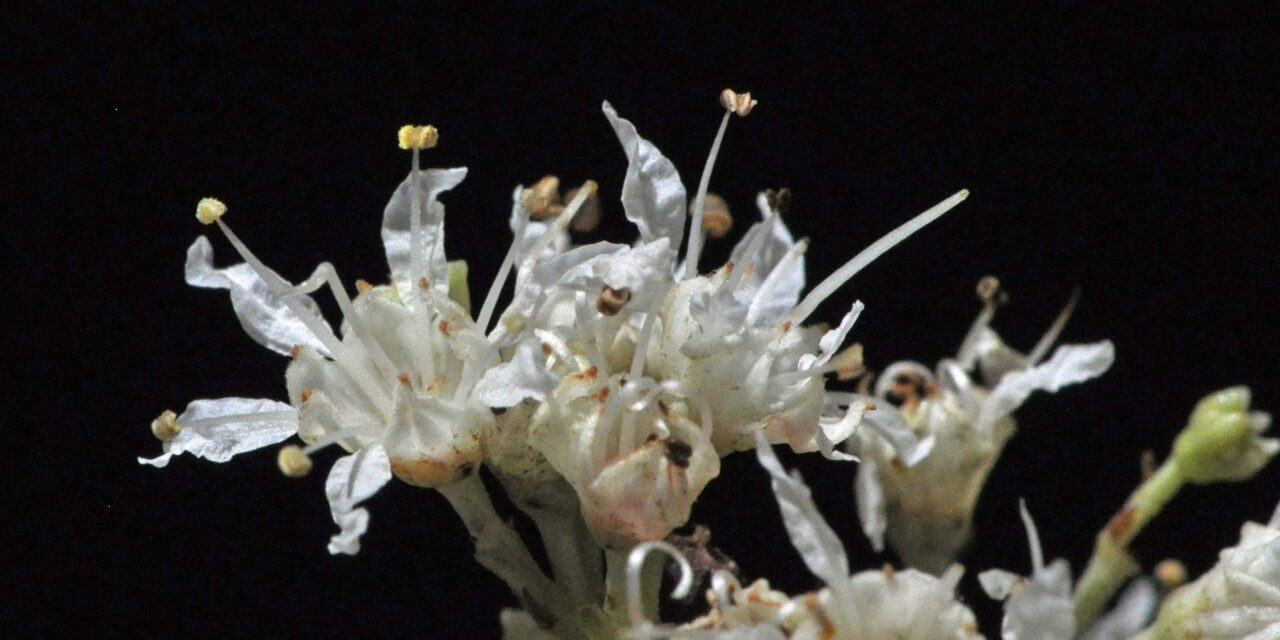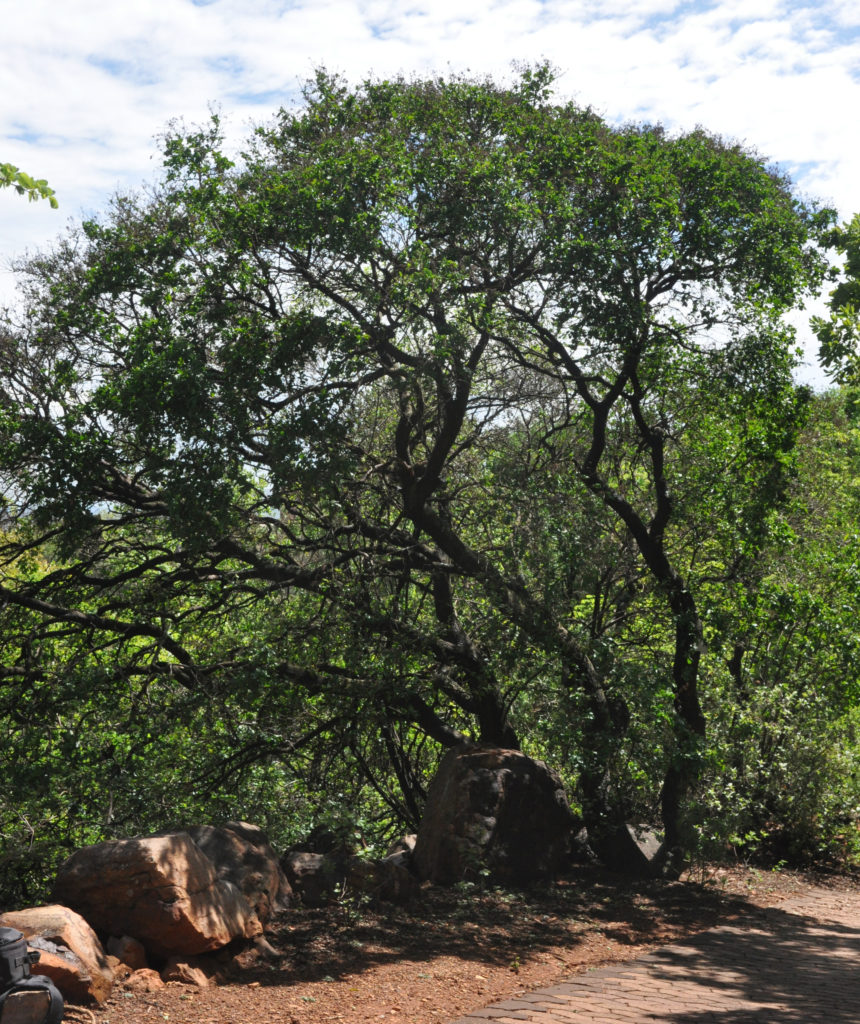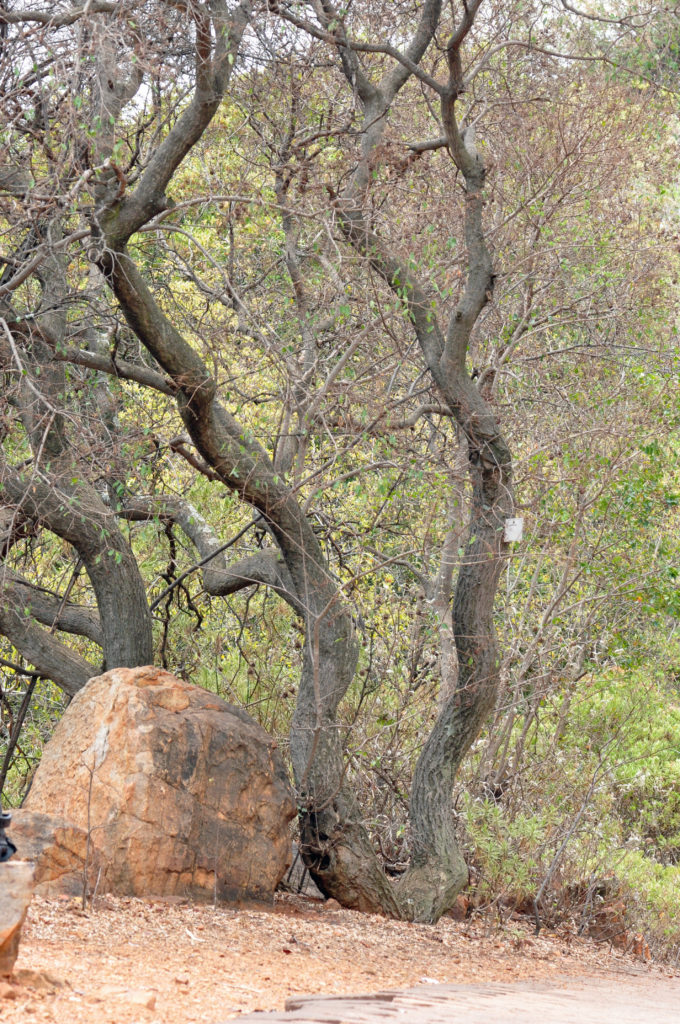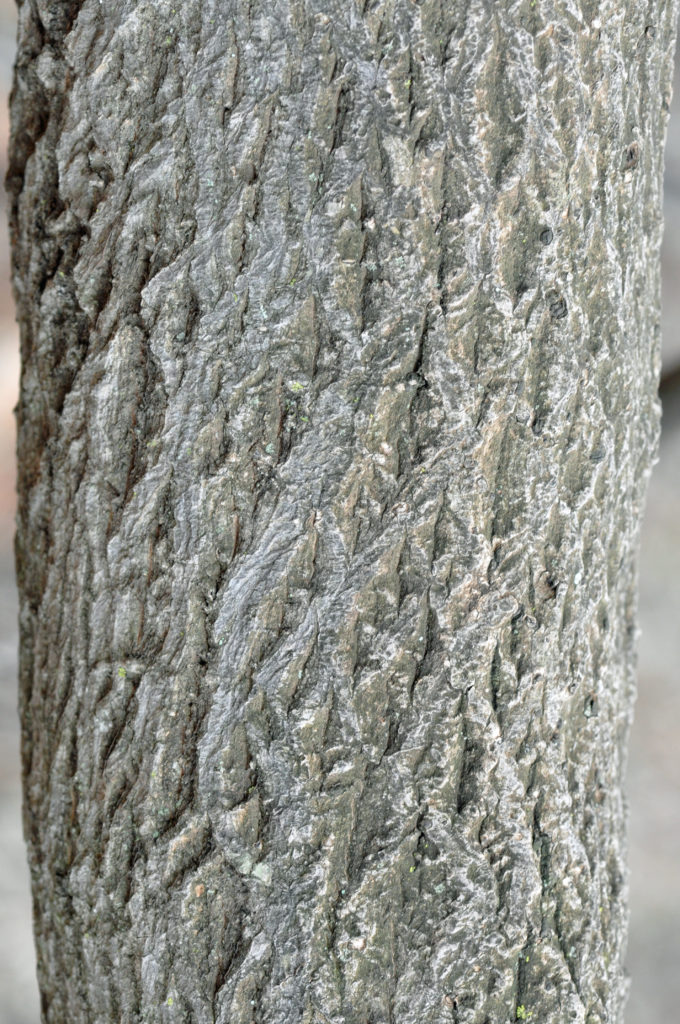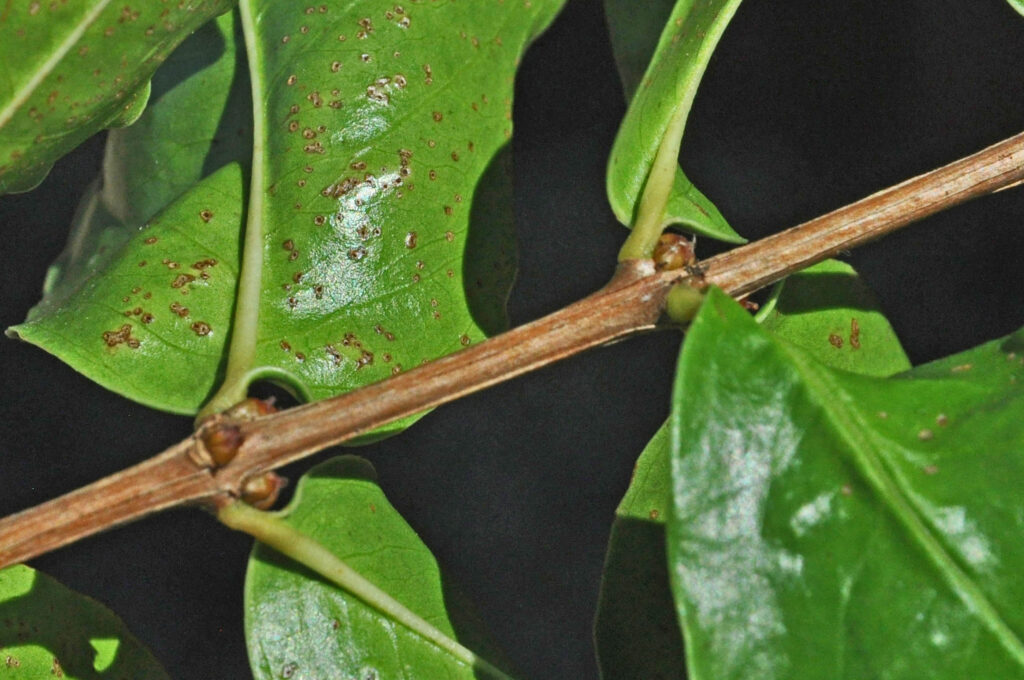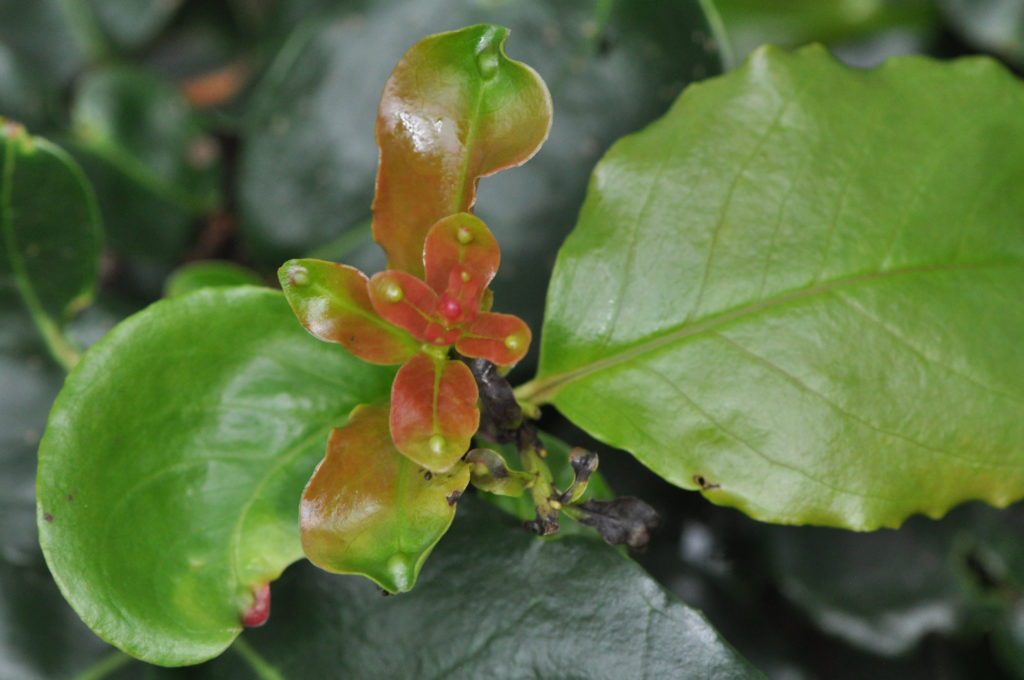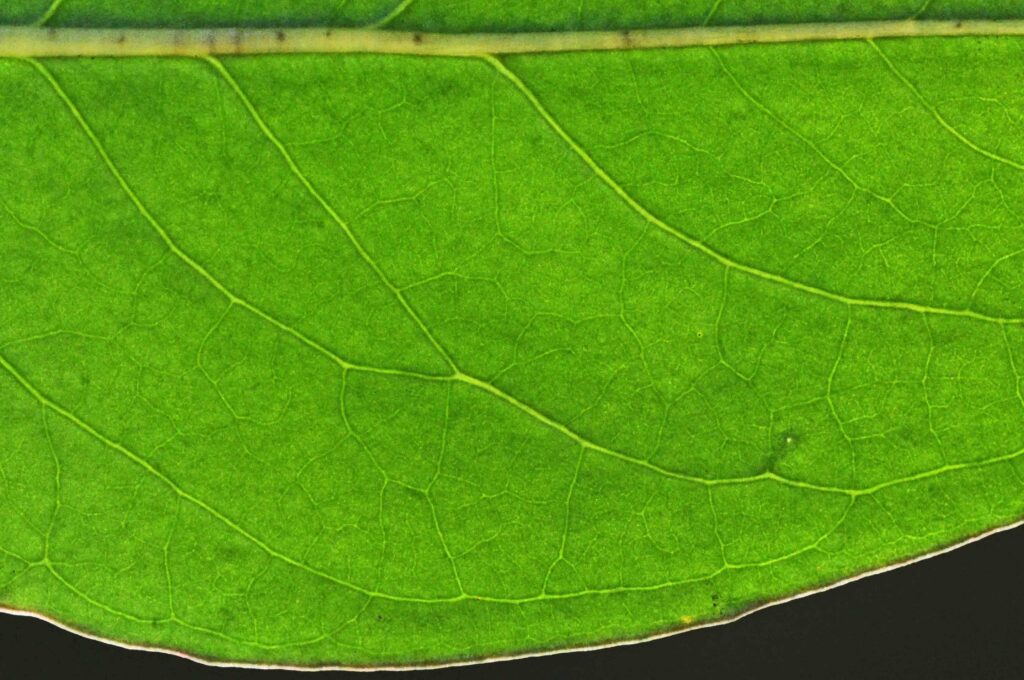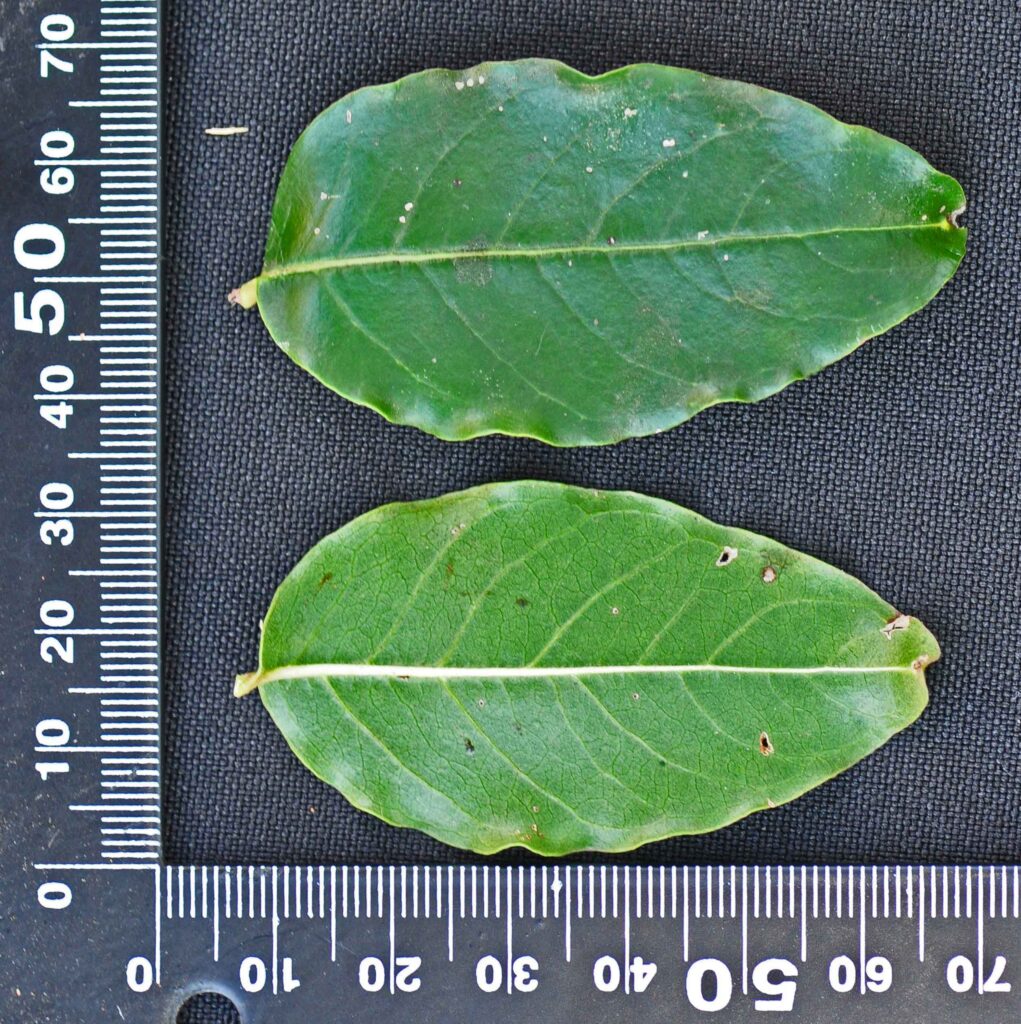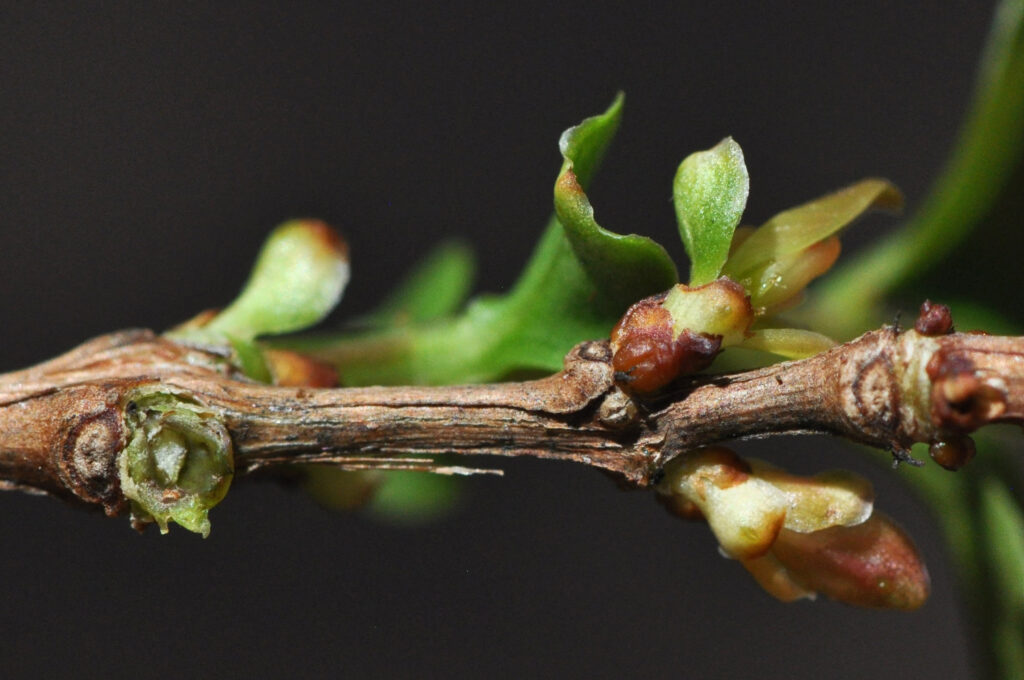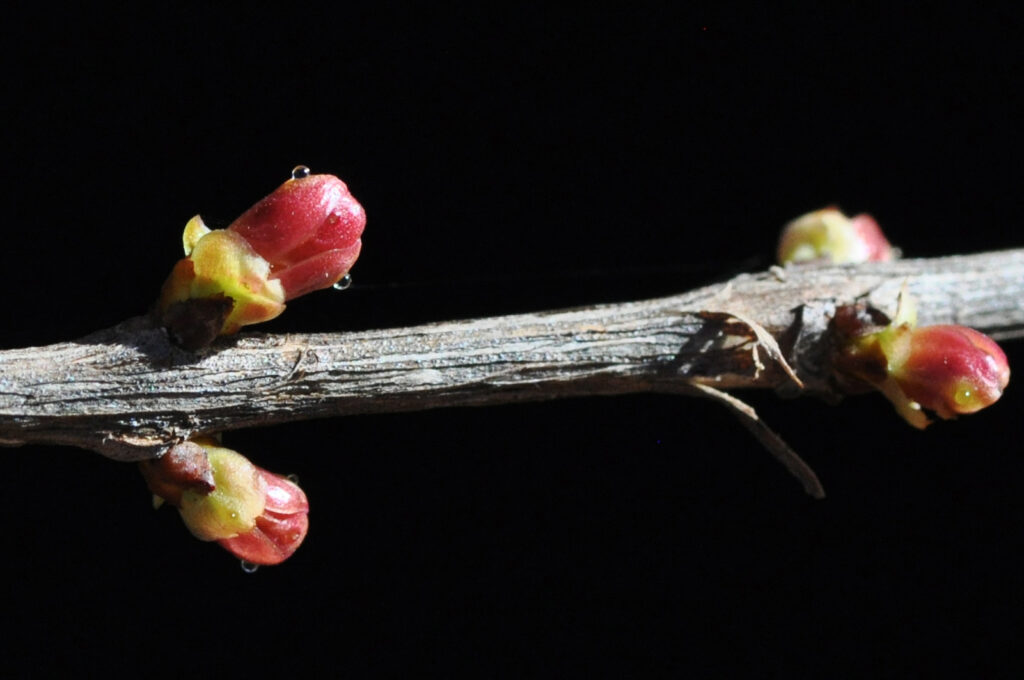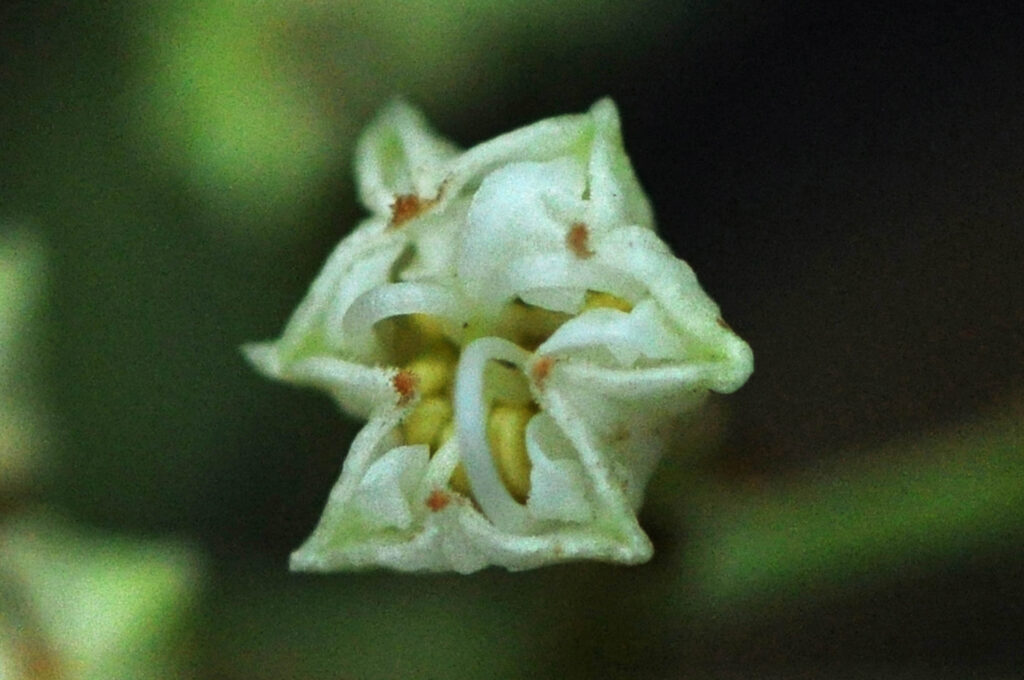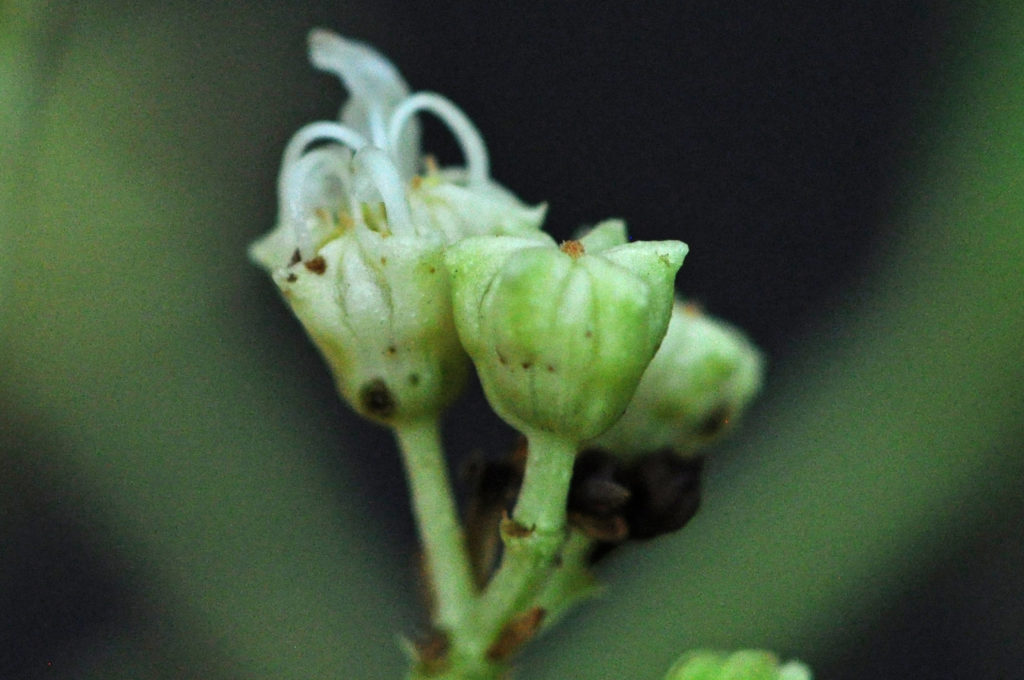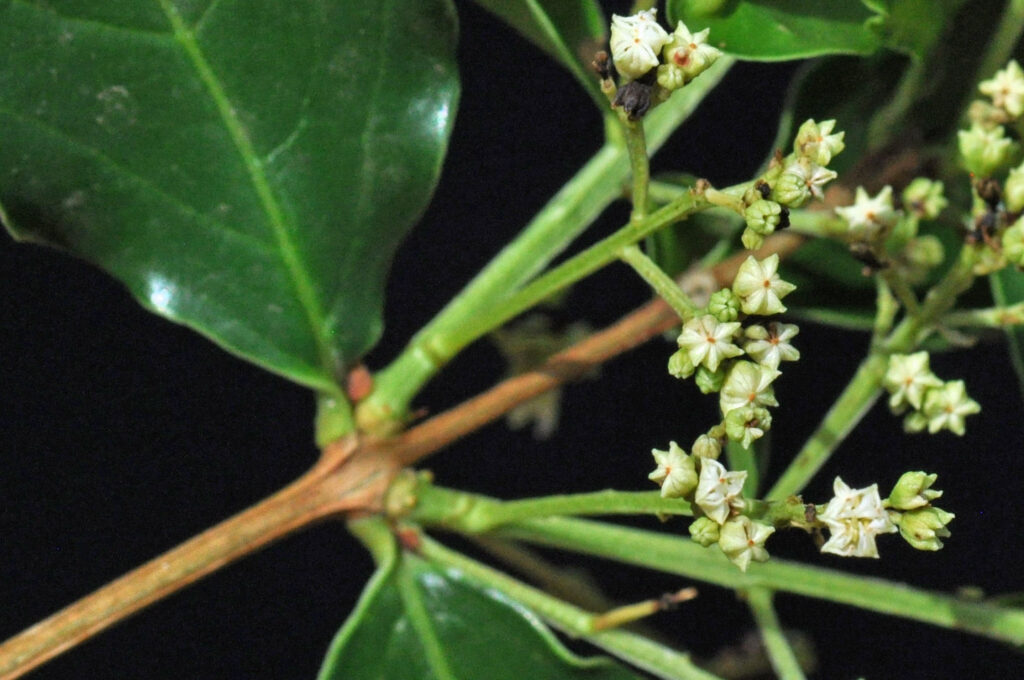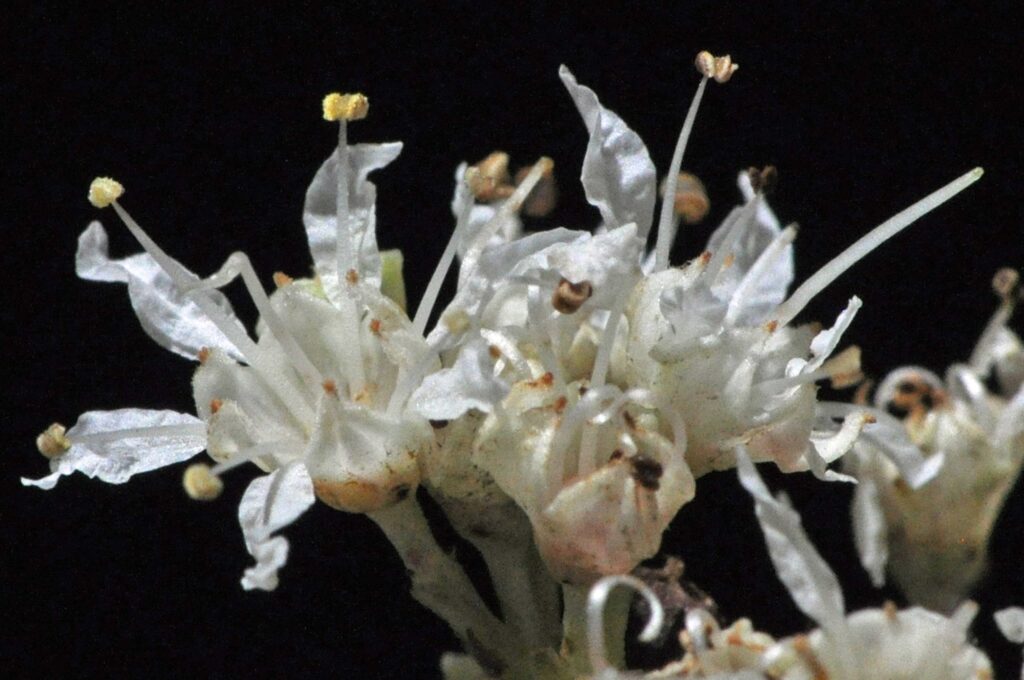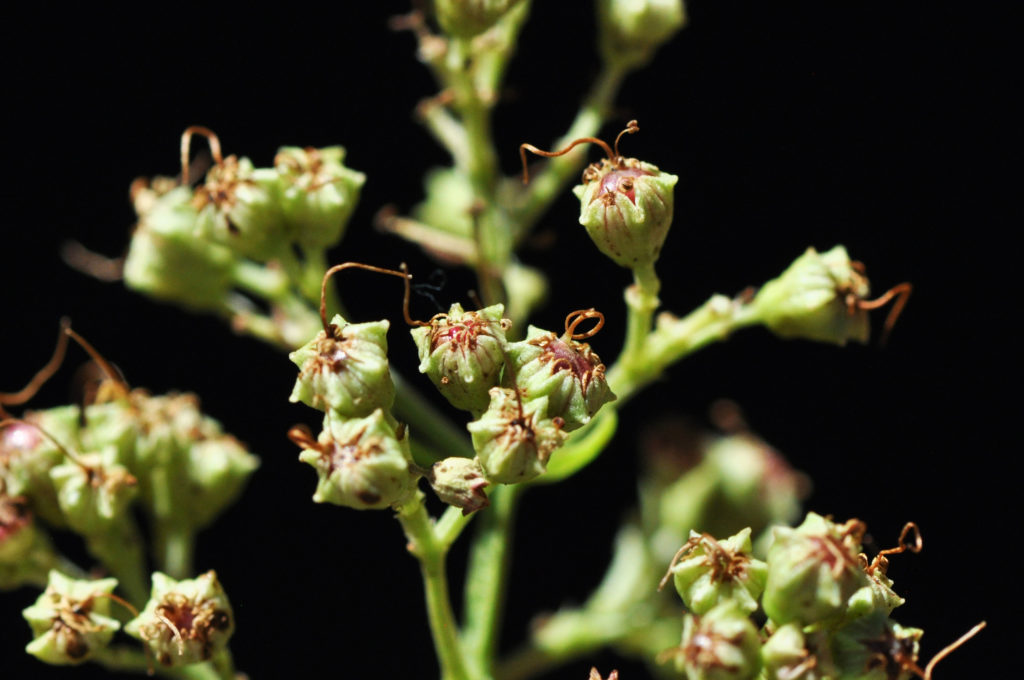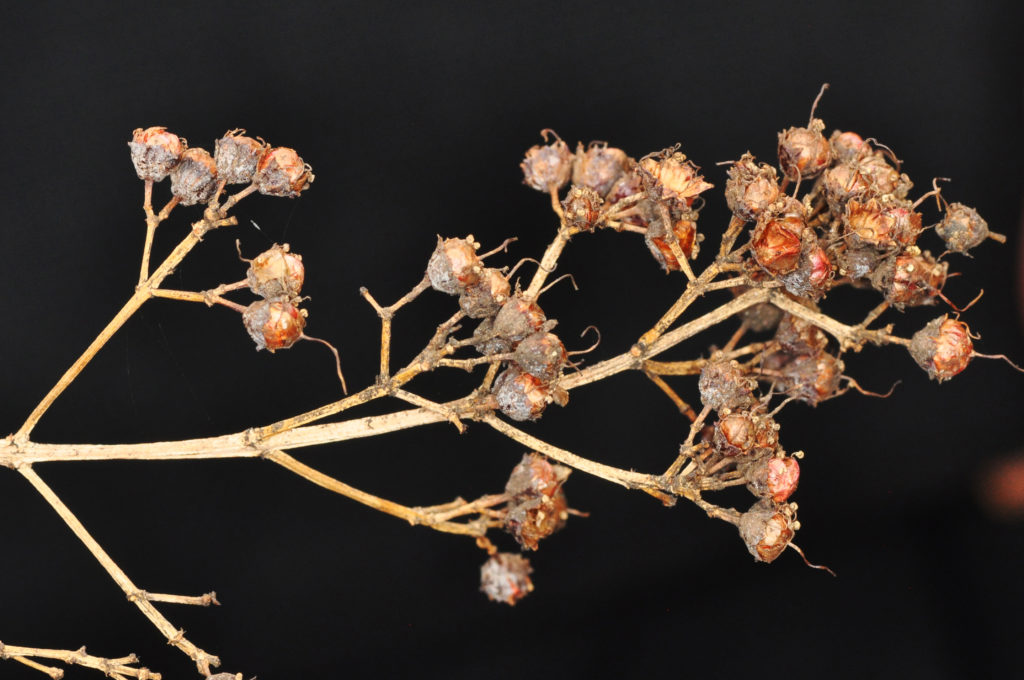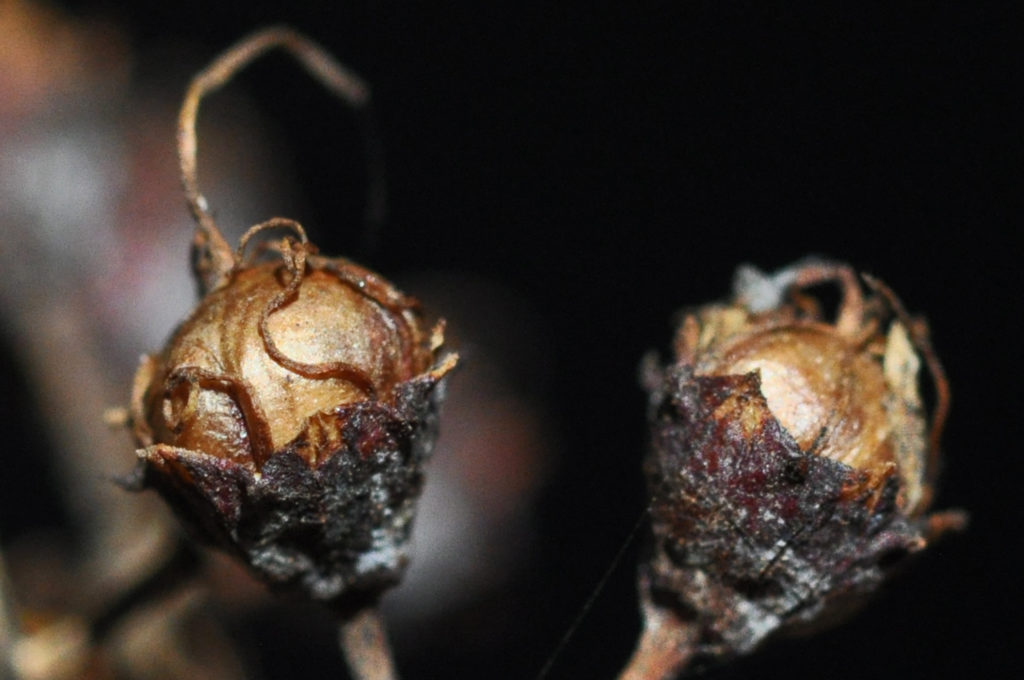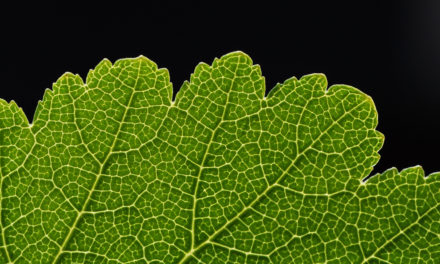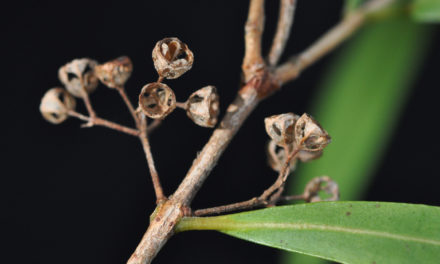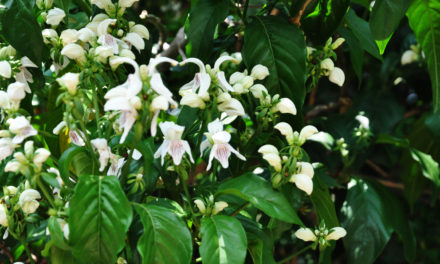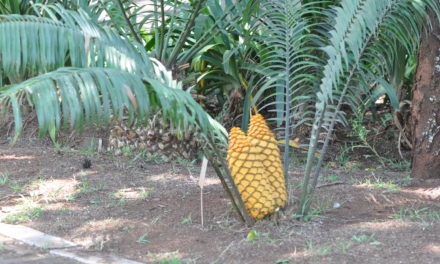General Info – summary
This usually small Tree is usually 14m high, with squarish young branches. Simple, leathery, shiny Leaves are entire, opposite & decussate with an apical midrib gland. The small white, usually 6-merous, bisexual, regular Flowers have crinkled petals and attract insects. They occur in terminal or axillary panicles. Fruit is a small capsule with a persistent calyx and style – releasing winged, wind-dispersed seeds.
Description
Galpinia transvaalica
Previous name: Galpinia parviflora.
SA Tree No. 523.
Common names: (Afr) Brosblaar, Knoppieblaar. (Eng) Galpinia, Tonga (NE of Eswatini) Gardenia, Transvaal-privet, Wild Pride of India. (isiZulu) Umdlampangela, Umhlalamahubulu, Umphisamakhasa, Umhlophe. (siSwati) Umdubu, Umdvubu.
Family: Lythraceae (Pride of India and pomegranate family). These flowering plants currently include 32 genera and about 630 species – mostly herbs in the tropics. Shrubs and trees often have flaky bark. The Leaves are simple and usually opposite. The bisexual, usually 4-merous, usually actinomorphic Flowers have crumpled petals in the bud that emerge wrinkled and overlapping. They are 4, 6 or 8-merous. There are usually twice the number of Stamens as petals. These stamens are usually in 1 or 2 whorls. Here the one whorl has longer stamens. The simple compound Pistil usually has 2-4 Carpels with many ovules. The Style and Stigma are simple. Fruit is usually a dry dehiscent capsule. The Seeds are flattened and /or winged and have a many layered outer integuments.
Name derivation: Galpinia – named after Earnest Edward Galpin (1858-1941). He was a South African banker interested in botany and became one of the greatest South African plant collectors. He discovered Galpinia transvaalica. This is the only accepted species of the genus Galpinia. transvaalica – of the old Transvaal.
Conservation: National Status: L C. (Least Concern). Assessment Date: 2005 (W. Foden and L. Potter).
Tree
This is a shrub or a small to medium Tree with a scant Crown (photo 485) and is usually about 6m but may reach 14m high. The trunk is often crooked and multi-stemmed (photo 978). The Bark is initially smooth. It ages to become rough, dark grey and ridged in more than one direction (photo 975). The pale grey and smooth Branches usually occur quite low-down. Young, brown and shiny branches are 4 angled (photo 437 under flowers). They mature becoming pale and smooth.
- 485. 2016/11/15. Pretoria NBG. Photo: David Becking.
- 978. 2016/10/18. Pretoria NBG. Photo: David Becking.
- 975. 2016/10/18. Pretoria NBG. Photo: David Becking.
Leaves
In this largely evergreen tree, the leathery, shiny and thickish Leaves are simple (have a single blade which may have incisions that are not deep enough to divide the blade into leaflets). They are hairless, opposite, and usually decussate (opposite pairs of leaves have successive pairs at right angles to each other i.e. rotated 90 degrees along the stem when viewed from above – photos 437 & 670). The square young stems influence this. Leaves are up to 9 x 4,5cm and are elliptic-obovate, oval or ovate (egg-shaped). The upper surface of the mature Blade is dark green and shiny but paler and dull below (photo 492). Old leaves are red. There is a conspicuous Gland on the Midrib just below the leaf Apex (photo 670). The midrib does not extend beyond this gland. This is more visible on the younger, reddish or copper coloured, leaves in early summer. It causes the apex to become diagnostically recurved – (photo 670). With a strong hand lens, Pellucid (clear, almost transparent in transmitted light) dots may be visible in young leaves. The lateral Veins are more visible if the leaf is examined against a strong light (photo 156). Here the veins can be seen heading towards the margin then heading towards the apex and joining with other veins before reaching the margin. The markedly wavy Margin (photo 670) is entire (with a continuous margin, not in any way indented). The tapering Apex may be sharply or bluntly pointed, rounded or notched (photo 492) and may be twisted at the end. The Base tapers and becomes slightly narrowed or rounded. The Petiole (leaf stalk) is thick and very short, 3-4mm long – (photo 492) or absent and is grooved on top (photo 670). Stipules (basal appendage of the petiole) are present but fall early.
- 437. 2018/09/16. Kirstenbosch NBG. Photo: David Becking.
- 670. 2017/10/17. Pretoria NBG. Photo: David Becking.
- 156. 2018/03/14. Pretoria NBG. Photo: David Becking.
- 492. 2017/08/15. Pretoria NBG. Photo: David Becking.
Flowers
The attractive, faintly scented, bisexual white and short lived Flowers are actinomorphic (Regular, symmetrical. Flowers are 5s or 6s-merous and vertically divisible into similar halves by more than 1 plane passing through the axis). Here they emerge from 6-angled buds (photo 378). They occur in terminal or axillary Panicles (indeterminate, branched inflorescence with stalked flowers – photo 375). Flowers are small – up to 1,3cm in diameter and occur in dense sprays in leaf axils towards or at the ends of branches. The flowers are perigynous (having sepals, petals, and stamens around the edge of a cuplike receptacle – that expanded tip of the flower stalk from which the floral parts develop). Each flower rests on a pedicel (stalk of a single flower – photo 382). The Calyx is a bell-shaped tube ending in ovate lobes that meet but do not overlap (photo 382). The lobes alternate with short appendages. The Corolla has impressive white crinkle Petals (photo 774) that arise from near the top of the corolla tube and they alternate with the sepals. The Stamen Filaments are attached to the mouth of the calyx tube and are initially folded inwards (photos 378 & 382). They eventually become distinctly exserted (sticking out – photo 774). The Stamens are opposite the petals and attached less than half way up the corolla tube. There are as many stamens as the corolla lobes. The Filaments are usually unequal in length and unfold as the flower develops. Each Anther is dorsifixed (attached by or at the back) and has 2 Thecae (pollen sacs – photo 774). There is a single Pistil (a unit of the Gynoecium, the female element of the flower, composed of the Ovary, Style and Stigma). The single, initially white Style is as wide as or slightly wider than the filaments (photo 774) and usually slightly shorter than the stamens. The incompletely 2 chambered sub-sessile Ovary contains many small Ovules. (Nov -Apr).
- 557 2017.10.17 Pretoria NBG. Photo: David Becking.
- 79 2016.10.25 Pretoria NBG. Photo: David Becking.
- 378. 2018/01/16. Pretoria NBG. Photo: David Becking.
- 382 2018.01.16 Pretoria NBG. Photo: David Becking.
- 375. 2018/01/16. Pretoria NBG. Photo: David Becking.
- 774. 2018/02/12. Pretoria NBG. Photo: David Becking.
Fruit
The almost spherical Fruit is membranous Capsule (a dry fruit resulting from the maturing of a compound ovary – of more than one carpel – usually opening at maturity by one or more lines of dehiscence). It is very small – up to 5mm in diameter, and red brown to black (photo 981). Each capsule dehisces irregularly. The persistent Calyx surrounds more than half of the fruit (photo 78) and here the remains of the filaments are also visible. The now thin, reddish and protruding remains of the styles are also visible at the tip (three photos below). The many flat Seeds are winged along the whole margin – indicating the wind dispersal mechanism. (Feb-Jul).
- 778. 2018/02/12. Pretoria NBG. Photo: David Becking.
- 981. 2016/10/18. Pretoria NBG. Photo: David Becking.
- 78. 2019/09/27. Pretoria NBG. Photo: David Becking.
Distribution & Ecology
This drought resistant Tree is endemic (Endemism is the ecological state of a species being unique to a defined geographic location) in southern Africa. They grow in warm summers, dry winters at medium to low altitudes and occur naturally in the Lebombo Mountains (800km long running N-S from Punda Maria in Limpopo province to Hluhluwe in KZN. They occur in Northern Kwa-Zulu Natal, Eswatini (Swaziland), Gauteng, Mpumalanga, southern Limpopo, Zimbabwe and Mozambique – southern, south-western and Inhaca Island (52 sq km and about 30 km across the sea from Maputo in southern Mozambique). These trees are often located from medium to low altitudes – usually in rocky places in the bushveld (a sub-tropical woodland ecoregion of southern Africa), scrub forest and forest edges. Animals, including the Giraffe, Kudu and elephant, browse the leaves. The faintly scented Flowers attract insects – including bees, flies, ants, beetles and, as a result, birds.
Ethnobotany
The relatively hard, fine-grained Wood is moderately dense and pale brown to yellowish brown. It is used for turning on a lathe and for making yokes, (a yoke is a wooden beam normally used between a pair of oxen or other animals to enable them to pull together on a load when working in pairs). This is an attractive tree with a good potential for the garden – even a small one. The Roots are non-aggressive, and both the flowers and fruits are attractive. It grows best in frost-free areas with summer rains. The plant is also used for bonsai. Domestic animals graze the Leaves.
References
Boon, R. 2010. Pooley’s Trees of eastern South Africa. Flora and Fauna Publications Trust, Durban.
Burrows, J.E., Burrows, S.M., Lotter, M.C. & Schmidt, E. 2018. Trees and Shrubs Mozambique. Publishing Print Matters (Pty) Ltd. Noordhoek, Cape Town.
Coates Palgrave, M. 2002. Keith Coates Palgrave Trees of Southern Africa, edn 3. Struik, Cape Town.
Foden, W. & Potter, L. 2005. Galpinia transvaalica N.E.Br. National Assessment: Red List of South African Plants version 2020.1. Accessed on 2023/06/23.
Lawrence, G. H. M, 1951. Taxonomy of Vascular Plants, The Macmillan Company, New York. Tenth Printing 1965.
Palmer, E. & Pitman, N. 1972. Trees of southern Africa, Balkema, Amsterdam, Cape Town.
Schmidt, S. Lotter, M. & McCleland, W. 2002. Trees and Shrubs of Mpumalanga and the Kruger National Park.
van Wyk, B. & van Wyk, P. 1997 Field guide to Trees of Southern Africa, Struik, Cape Town.
http://www.plantzafrica.com/plantefg/galpintrans.htm
http://treeco-treeco.blogspot.co.za/2013/04/galpinia-transvaalica-wild-pride-of.html
http://posa.sanbi.org/flora/browse.php?src=SP
http://www.botany.hawaii.edu/faculty/carr/default.htm

